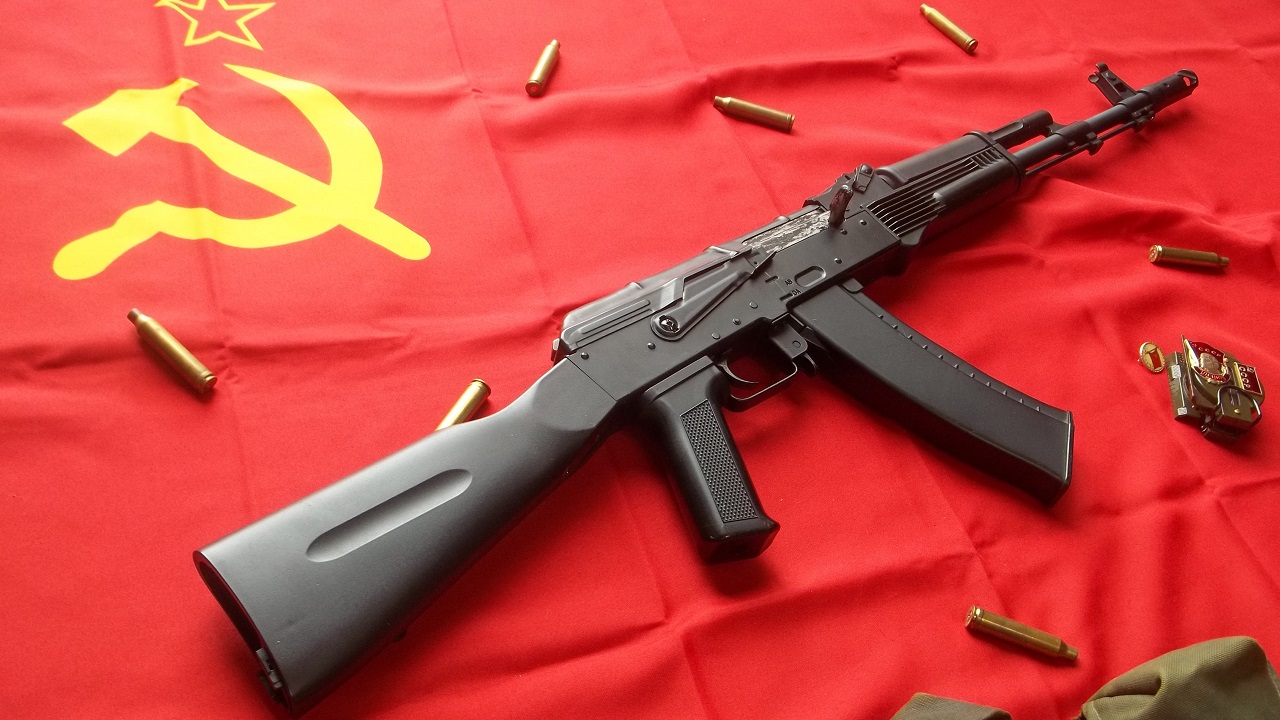Meet the AK-74: The AK-47 is arguably the most famous rifle in the world, as well as the most infamous in the world – though the M-16/AR-15 is a very close second — vilified hated by media pundits and politicians of leftist political stripe, thanks to the weapon’s unfortunate use in tragedies such as the Stockton, Calif. schoolyard massacre of 1989.
What’s not as famous/infamous to folks who aren’t gun-savvy is the AK-74, which is not a mere dyslexic typo or anagram of the AK-47 but is indeed a separate firearm and the successor to Генера́л-лейтена́нт/Generál-leytenánt (Lieutenant General) Mikhail Kalashnikov’s original design.
While the AK-74 may not be quite as well known as its predecessor, it is still a very historically significant weapon…especially considering that it’s the current standard-issue rifle of the Ukrainian Armed Forces…and the Russian Army as well, thus making for a brother-against-brother conflict in more ways than one.
AK-47: Origins & Specifications
The official full name of the weapon is the Avtomat Kalashnikova obraztsa 1974 goda/Автомат Калашникова образца 1974 года, which literally translates into “Kalashnikov assault rifle model 1974.” Tovarish (“Comrade”) Kalshnikov himself was indeed the inventor of the AK-74, and he indeed designed it in 1974, hence the digital portion of the alphanumeric designation. Superficially, the two firearms look very similar, and both are gas operated with a rotating bolt. A goodly number of the parts are interchangeable between the good guns, with the following notable exceptions: barrel, bolt assembly, bolt carrier, receiver, and magazines.
And the ’74 retains the legendary reliability, ruggedness, and caveman simplicity — both weapons can be field-stripped in one minute without using any tools — of the ’47.
The key distinction of the newer (relatively speaking) rifle is that instead of the 7.62x39mm round, it employs a 5.45x39mm cartridge. The motivation for the development of this smaller-caliber round came from, believe it or not, the American “capitalist imperialist running dog” (so to speak) M-16 rifle and its .223 Remington/5.56x45mm cartridge.
In other words, as Travis Pike noted in a July 2021 article for SOFPREP, “The AK-74 took cues from the M16 rifle and reduced the caliber to the more intermediate 5.45x39mm round. The days of 7.62 rifles ruling the battlefield were over, and the Russians recognized the potential behind a smaller, more intermediate caliber.” The standard magazine capacity remains 30 rounds.
Like the AK-47, the ’74 has a standard barrel length of 16.3 inches, but the latter gun is 1 pound lighter at 6.7 pounds. The cyclic rate of fire with the AK-47 will be 600 rounds per minute, whilst the AK-74 churns out the ammo at a slightly faster cyclic rate of 650 rpm.
AK-74 and 5.45x39mm vs. AK-47 and 7.62x39mm Round: Which One Is Better?
Well, that depends on how you define better, i.e. what your mission parameters are. The AK-74/5.45x39mm pairing is an inherently more accurate weapon and caliber combo that the AK-47/7.62x39mm pairing, in addition to the benefit of lighter recoil. Meanwhile, to cite Travis Pike again, “The lighter and smaller 5.45 cartridge tends to yaw and fragment when it hits the body, whereas the 7.62 variant punches straight holes… Beyond that, the AK-74 increases the effective range of a soldier to 500 meters.”
On the other hand, in a June 2020 article for Firearms News, David M. Fortier articulates “5 Reasons Why 7.62x39mm Beats 5.45x39mm”: Availability, Diversity of Loads, Terminal Performance (the 7.62 is after all still the inherently more powerful cartridge), Cost (boy oh boy, is this ever a big one nowadays), and Subsonic (this is an option, as most 7.62x39mm loading are still in the supersonic velocity range).
Continually Battle-Proven
The AK-74 received its “first baptism of fire” during the Soviet-Afghan War of 1978-1989, and eventually completely supplanted the AK-47 as the standard-issue rifle of both the Red Army and the post-Soviet armed forces of the Russian Federation.
At last count, it has been used in a total of 26 conflicts, with over 5 million specimens produced worldwide, and the aforementioned brother-against-brother conflict in Ukraine, as well as its official usage by at least 25 different countries, goes to show that it isn’t going away anytime soon.
Christian D. Orr has 33 years of shooting experience, starting at the tender age of 14. His marksmanship accomplishments include: the Air Force Small Arms Ribbon w/one device (for M16A2 rifle and M9 pistol); Pistol Expert Ratings from U.S. Customs & Border Protection (CBP), Immigration & Customs Enforcement (ICE), and the Federal Law Enforcement Training Center (FLETC) Criminal Investigator Training Program (CITP); multiple medals and trophies via the Glock Sport Shooting Foundation (GSSF) and the Nevada Police & Fires Games (NPAF). Chris has been an NRA Certified Basic Pistol Instructor since 2011. In his spare time, he enjoys (besides shooting, obviously) dining out, cigars, Irish and British pubs, travel, USC Trojans college football, and Washington DC professional sports.

